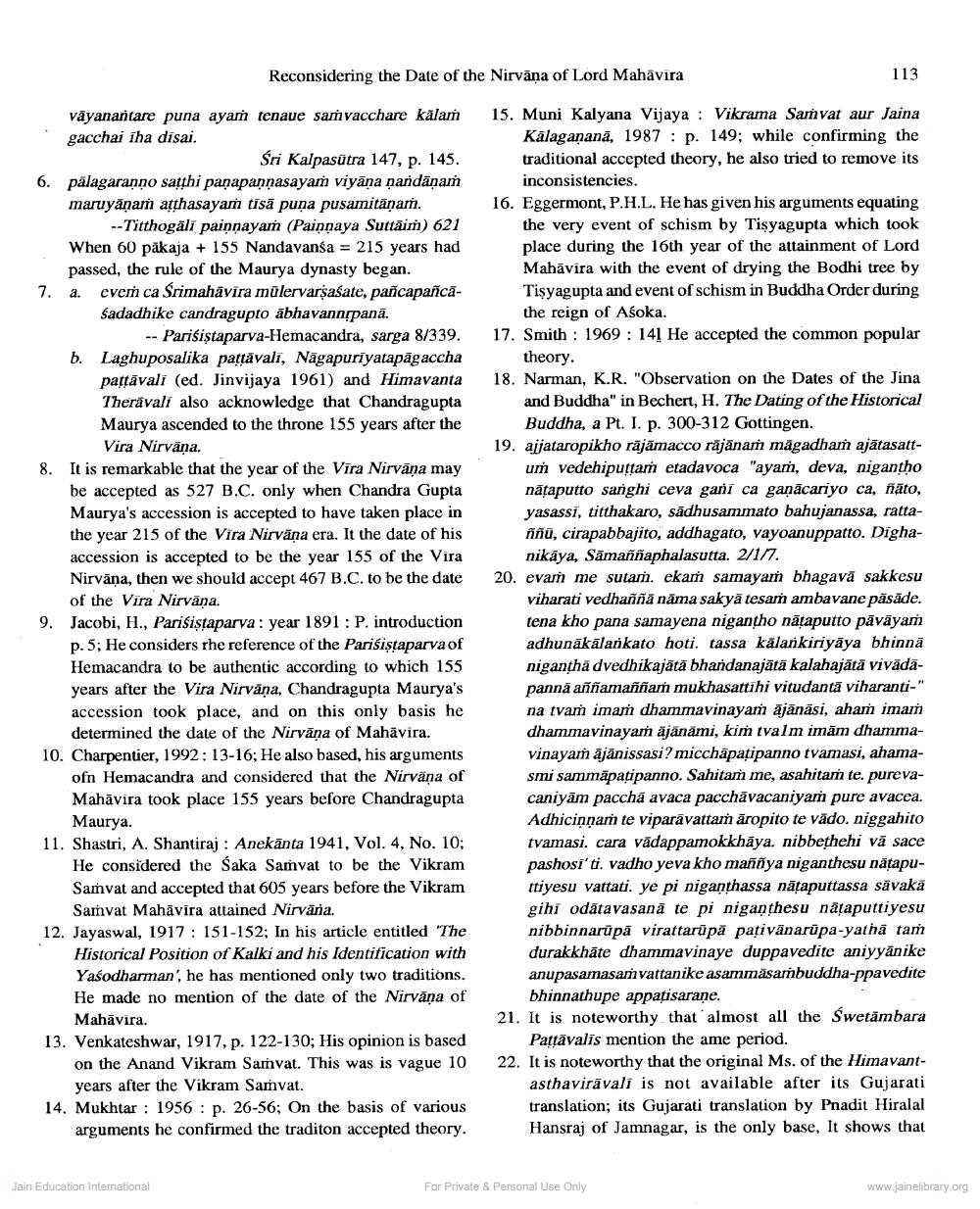________________
Reconsidering the Date of the Nirvana of Lord Mahavira
113
vāyanantare puna ayam tenaue sarnvacchare kälar gacchai iha disai.
Sri Kalpasūtra 147, p. 145. 6. pälagaranno sathi panapannasayam viyana nandānam maruyana athasayam tisā puņa pusamitānam.
-- Titthogāli painnayar (Painnaya Suttaim) 621 When 60 päkaja + 155 Nandavansa = 215 years had
passed, the rule of the Maurya dynasty began. 7. a. eveṁ ca Srimahāvīra mülervarsasate, pañcapanca
sadadhike candragupto ābhavannspana.
-- Parisistaparva-Hemacandra, sarga 8/339. b. Laghuposalika pattāvali, Nägapuriyatapägaccha
pattāvali (ed. Jinvijaya 1961) and Himavanta Theravali also acknowledge that Chandragupta Maurya ascended to the throne 155 years after the
Vira Nirvana. 8. It is remarkable that the year of the Vira Nirvana may
be accepted as 527 B.C. only when Chandra Gupta Maurya's accession is accepted to have taken place in the year 215 of the Vira Nirvana era. It the date of his accession is accepted to be the year 155 of the Vira Nirvana, then we should accept 467 B.C. to be the date
of the Vira Nirvana. 9. Jacobi, H., Parisistaparva : year 1891 : P. introduction
p. 5; He considers rhe reference of the Parisistaparva of Hemacandra to be authentic according to which 155 years after the Vira Nirvana, Chandragupta Maurya's accession took place, and on this only basis he
determined the date of the Nirvana of Mahavira. 10. Charpentier, 1992: 13-16; He also based, his arguments
ofn Hemacandra and considered that the Nirvana of Mahāvira took place 155 years before Chandragupta
Maurya. 11. Shastri, A. Shantiraj: Anekānta 1941, Vol. 4, No. 10:
He considered the saka Samvat to be the Vikram Samvat and accepted that 605 years before the Vikram
Samvat Mahāvīra attained Nirvana. 12. Jayaswal, 1917: 151-152; In his article entitled "The
Historical Position of Kalki and his Identification with Yasodharman', he has mentioned only two traditions. He made no mention of the date of the Nirvana of
Mahāvīra. 13. Venkateshwar, 1917, p. 122-130; His opinion is based
on the Anand Vikram Sarvat. This was is vague 10
years after the Vikram Samvat. 14. Mukhtar : 1956 : p. 26-56; On the basis of various
arguments he confirmed the traditon accepted theory.
15. Muni Kalyana Vijaya : Vikrama Samvat aur Jaina
Kālagananā, 1987 : p. 149; while confirming the traditional accepted theory, he also tried to remove its
inconsistencies. 16. Eggermont, P.H.L. He has given his arguments equating
the very event of schism by Tişyagupta which took place during the 16th year of the attainment of Lord Mahāvira with the event of drying the Bodhi tree by Tisyagupta and event of schism in Buddha Order during
the reign of Asoka. 17. Smith : 1969 : 141 He accepted the common popular
theory. 18. Narman, K.R. "Observation on the Dates of the Jina
and Buddha" in Bechert, H. The Dating of the Historical
Buddha, a Pt. I. p. 300-312 Gottingen. 19. aijataropikho rājāmacco răjänar māgadham ajätasatt
um vedehiputtar etadavoca "ayam, deva, nigantho nātaputto sanghi ceva gani ca ganācariyo ca, fato, yasassi, titthakaro, sādhusammato bahujanassa, rattaññu, cirapabbajito, addhagato, vayoanuppatto. Digha
nikaya, Samaññaphalasutta. 2/17, 20. evar me sutam. ekam samayam bhagavā sakkesu
viharati vedhanna nama sakyä tesar ambavane päsāde. tena kho pana samayena nigantho nätaputto pavayam adhunākālankato hoti. tassa kalankiriyaya bhinnä nigantha dvedhikajätā bhandanajäta kalahajätä vivadapannā aññamaññar mukhasattihi vitudantä viharanti." na tvaṁ imaṁ dhammavinayam äjänäsi, aham imam dhammavinayarn äjänami, kim tvalm imam dhammavinayam äjänissasi? micchapatipanno tvamasi, ahamasmi sammăpatipanno. Sahitam me, asahitam te. purevacaniyām pacchã avaca pacchāvacaniyam pure avacea. Adhicinnar te viparávattam āropito te vădo, niggahito tvamasi. cara vādappamokkhaya, nibbethehi vă sace pashosi'ti. vadho yeva kho maññya niganthesu nätaputtiyesu vattati. ye pi niganthassa nātaputtassa sävaka gihi odātavasana te pi niganthesu nätaputtiyesu nibbinnarüpa virattarūpā pati vänarüpa-yatha tam durakkhāte dhammavinaye duppavedite aniyyänike anupasamasamvattanike asammasambuddha-ppavedite
bhinnathupe appațisarane. 21. It is noteworthy that almost all the Swetambara
Pattavalis mention the ame period. 22. It is noteworthy that the original Ms. of the Himavant
asthavirāvali is not available after its Gujarati translation; its Gujarati translation by Pnadit Hiralal Hansraj of Jamnagar, is the only base, It shows that
Jain Education International
For Private & Personal Use Only
www.jainelibrary.org




